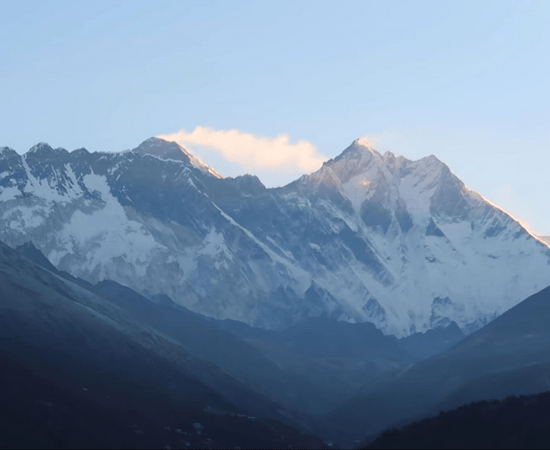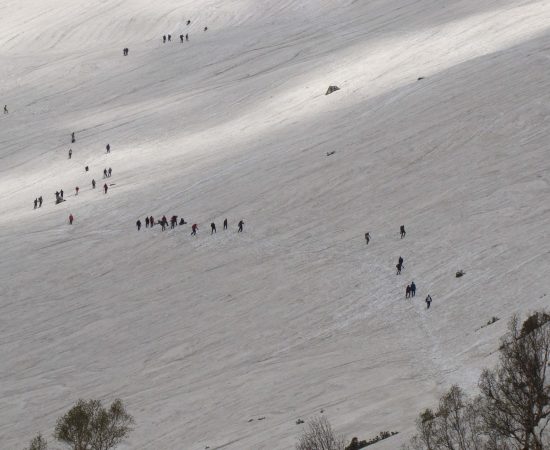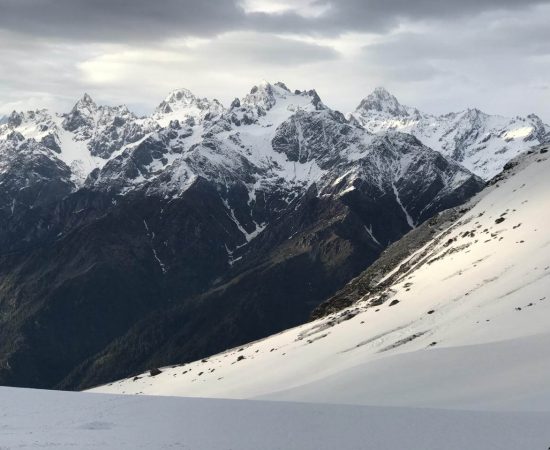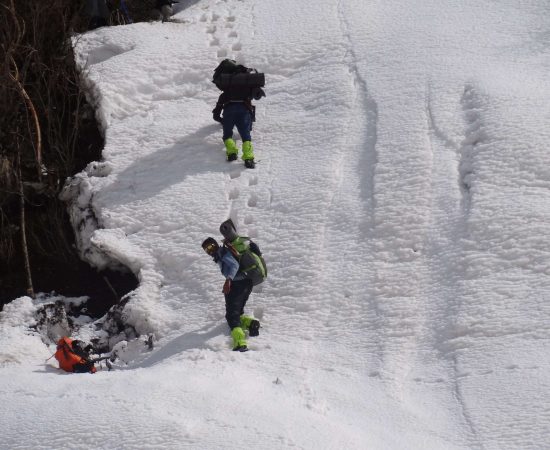Pin Bhaba Pass Trek
Shimla, Himachal Pradesh
Rated 4.9/5.0 on TripAdvisor. 550 Reviews


Key Highlights
- Altitude : 4865 m. 15900 ft
- Time : 7 Days - 6 Nights
- Region: Parvati and Spiti Valley
- Best Time: Mid. June to October
- Distance: 62 kms
- Grade: Difficult
Overview
PIN BHABA PASS TREK
The lush, verdant Kinnaur Valley is connected to the arid Spiti region via the well-known Pin Bhaba Pass Trek. The last settlements of these two quite diverse valleys are connected by our trek. It's hard to imagine how two such polar different worlds could survive on opposing sides of a Himalayan pass. Nearly everything, including the topography, inhabitants, languages, food, religion, and so on, drastically varies between the two valleys. We start off by taking the historic Toy train to Shimla, and then we continue on a road trip via the Sutlej gorges in Kinnaur to the last settlement, Kafnu. Through the Bhabha Pass and into Spiti's culturally and geographically rich moonscape, we travel a modest five days. Spiti, in contrast to Kinnaur, which is populated by Hindus who live in wooden huts clinging to the hill, has a significant Buddhist presence, complete with monasteries and fluttering prayer flags. The Gaddi shepherds, who spend their summers moving from one grazing area to another before returning to the plains in the winter, are a fascinating group to interact with and learn about during this trek. Every alpine adventure, as you are aware, calls for careful preparation, a strategy that allows for enough flexibility in observing and dealing with conditions, and one that is kept together by conquering mind, body, and spirit during the wonderful Himalayan trek.
Cost Per Person
Key Highlights
- Altitude : 4865 m. 15900 ft
- Time : 7 Days - 6 Nights
- Region: Parvati and Spiti Valley
- Best Time: Mid. June to October
- Distance: 62 kms
- Grade: Difficult
Complete
➽ Itinerary of Trek
When you reach kanfu, one of our employees (a trek leader or guide) will meet you and take you to the next programme. Briefings and orientations will be offered as required. A night at the campground or guest house
Starting out on a dusty road, we pass Homti's village on the left. The valley becomes more narrow as we get closer to camp before widening into vast spaces. We start the journey with the Bhaba River on our right. Before heading back to the river, we cross across and trek quite high up into coniferous trees. The river is on our right as we reach Mulling's expansive meadow after making our way back through the forest. We can see some magnificent waterfalls and melting glaciers on the Bhaba River. Travel time (4 -5 Hrs.). Spend the night camped.
Our next campground at Kara is only a short distance away today (3 Hrs.). We go on walking with the Bhaba River on our right as we pass through the wide, verdant valley. In between, we cross a river and stroll down a path lined with flowers and scattered with tiny stones. Next, we turn right and go down a winding route to our second campsite, which is situated in a magnificent meadow. A wonderful chance to see Gaddi herders while travelling. Trek Time is here! (3-4 hrs.). Spend the night in camps.
For the Bhaba Pass, Phustirang serves as the starting point. From Kara, we go onward to the intersection of two valleys, where we virtually do a U-turn to enter the Bhaba Valley. From there, we slowly climb a small trail to the foot of the pass while keeping the glacier stream on our right. We begin to see glaciers, ice, and snowy peaks as we move closer to the Pass. We'll see a lot of Gaddi shepherds along the road caring for huge herds of sheep and goats since this is their path. Just above the campground, a large grazing pasture with horses and sheep roams the landscape. Because of the sediment in the river, it divides into several smaller channels. To investigate and acclimatise, we may take a little trek above the campground. Trek Period (3 hrs.). Nighttime Camp.
It's finally the big day. We walk on stones, moraine, scree, and steep terrain without a proper track to reach the Bhaba Pass (4865m), which separates the lush, green Kinnaur Valley from the parched, dry Spiti Valley. On a bright and clear day, this hike is beautiful, offering stunning views of the mountains in the Pin Valley. It's quite possible that snow and ice will blanket the pass. Occasionally, shepherds and their large flocks of sheep may go with us. The Gaddi shepherds and yak herders dwell at Bara Bulder, which is reached after a long descent from the mountain. Trek Time is here! (7-8 hrs.).
We load up today and travel to the Mudh Village roadhead over the Pin River. After saying farewell to our Horsemen, the route to Mudh is a long downward walk which seems never ending. Spend the night at Mud.
Today marks the conclusion of the trek and we board our vehicles which will drop us to Kaza the commercial capital of Spiti. Here, we will say goodbye to the team and finish our awe-inspiring journey from Bhabha valley to Spiti.
Enquiry For Group Bookings
Guidelines
➽ Preparation for Trek
As you well know, the great Himalayan trek is one that requires careful preparation, a strategy that allows for enough flexibility to adapt to whatever challenges may arise.
Therefore, here are some things to consider before setting out on your trek:
⦿ Physically – You should start working out at least a month before signing up for a program if you want to be physically prepared for the rigours of a journey. Strengthen your legs by jogging and working out regularly to increase your stamina. To better acclimatise to the environment and increase your resilience on the walk, you should give up smoking and undertake breathing exercises twice a day. Engage in vigorous physical activity, such as playing sports, doing Yoga, or running.
⦿ Mentally –
Getting in shape physically is essential, but mental preparation is just as crucial for a successful walk. Take time to enjoy your regular activities, maintain a healthy diet and sleep schedule, and unwind before embarking on a hike. Predictions regarding the journey should not cause mental worry. Spend time with your closest pals to recharge your batteries and renew your spirit. Pre-trek preconceptions are unwarranted since the first contact with the other trekkers is certain to be a source of inspiration and energy. Conditions during the walk will contribute to the increase in mental readiness. The mental repercussions of physical disadvantages will not be ignored. So, when you hike, pay attention to different regions of your body and purposefully relax them. If you want to enjoy your hike, you should learn to loosen up a little, particularly in the hips. Think about your descent as a simple dance, and enjoy the natural rhythms that the path and your body can discover together gradually, whether you're on a flowing downhill route or a frightening slope. Try out a few new walking techniques to add some fun to your commute without worrying about getting somewhere in particular. Maintaining mental fitness mostly requires a willingness to relax and take in the journey, rather than subjecting oneself to undue stress.
⦿ Technically-
Get the right size hiking boots and go for it, from a technical standpoint. You should make use of 60 litres. To become acclimated to carrying heavy items, it is recommended to utilise a backpack on a regular basis. Get a hiking stick, a water bottle, some thermal socks, a fleece or feather coat, some long pants, a poncho, some flip-flops, and any devices you may need like a camera or a power bank (DSLR or digital camera).
Guidelines
➽ Things to Carry
- Good Trekking Boots: You need sturdy trekking boots with supportive high ankles. Don't bring your running shoes. U can carry extra floaters/flip flops also.
- Wear warm clothing, such three-layer coats, fleece upper, hollow fill or down-filled jackets. Carry full-sleeved T-shirt. Carry cotton hiking trek pants and warm pant for your lower body. Never bring shorts or jeans on a hike.
- Take top and bottom thermals with you.
- Quick dry towel with light weight and Personal toiletries. Suns cream lotion, sanitizer, tooth brush ad toothpaste, lip balm and antibacterial powder.
- Socks: Bring two pairs of regular socks and two pair of wool socks for wearing at night.
- A head torch is required.
- Sunglasses/ Goggle: UV-protected sunglasses are necessary to protect against sunlight and Snow Mountain.
- There should also be a woolen cap / balaclava, cap, neck gaiter cum face mask and warm fleece and waterproof summit gloves since it will be chilly. Keep waterproof gloves on hand since they become wet in the snow.
- Everyone taking part in the activity should have their own lunchbox, spoon, mug and water bottle/ hydration pack of 2 ltr.
- Raincoats/ponchos: Since snowfall and rain are frequent at high elevations, it is important to have one on hand so as to avoid getting wet.
- Trekking bag of 75 ltr with rain cover.
- Walking stik.
- Electronics: camera (optional) USB cable/USB solar charger, charger/earphones, Power bank fully charged.
- Personal first aid box. Emergency ration, energy bars, dry fruit, electoral/Ors
- Required Documents:
a) Registration Form
b) Medical Certificate (signed by a licensed MBBS physician)
c) NOC form (completed by the trekker)
d) 2 passport-size photos
e) ID Proof photo (not PAN)
g) Insurance upto 5 lac..
Guidelines
➽ How to Reach
Road distance:
Via Road. Shimla and Rampur provide frequent cab services as well as daily bus service to Kinnaur. Shimla and Delhi are linked nicely. You may travel from Delhi to Shimla in 8 to 10 hours via overnight bus (approx 435 KMS). Online ticket reservations are available at www.redbus.in and www.hrtc.gov.in Tip: Given the distance between Delhi and Shimla, the majority of Volvo private buses depart Delhi between 5 and 8 p.m. At 8.30 p.m., the final government bus departs from ISBT Kashmere Gate. Between Rs. 1,200 and Rs. 1,800 are charged by Volvo buses each sector from Delhi to Shimla and vice versa. Delhi to Shimla: Buses depart from Shimla to Delhi between 4 and 8 p.m., same like the return trip. You should expect to arrive in Delhi any time between six and ten in the morning. Plan your subsequent trips just after midday, leaving ample time for bus delays.
The closest train station is:
Chandigarh (260 miles) and Shimla (257 km) are the closest rail stations (370 kms). There are no direct railroad services to Kinnaur. Direct access to private taxi or bus services is available from the train station.
The closest airport:
As a result, there are no direct flights to Kinnaur, and the nearest airport is in Shimla. Which is accessible from Delhi? The airport serving Shimla is located at Jubbarhatti, 23 kilometres from the city, and is linked to Chandigarh and Kullu.
➽ Trip Cost Includes
- Conveyance within the journey.
- Tents that can be shared.
- Advanced and knowledgeable himalayan adventure trips guide.
- Cooks, helpers, and other necessary personnel.
- Vegetarian meals (breakfast, lunch, and dinner) along the journey
- Every organisational prerequisite for a journey
- First aid kit with portal oxygen.
- Camping fees and forest permits.
- All permissions for hiking.
- All meals will be supplied while on the hike. Freshly cooked meals will include a mix of indian, chinese, and continental cuisines.
- Lodging at a hotel, guest house, home, or in tents.
- All of the group's trekking equipment (tents at base camp, use of base camp facilities)
- All trip workers, including porters and mules for everyday items (such as food, tents, and utensils)
➽ Trip cost Excludes
- Airfare or other forms of transportation costs.
- Meals and hotel accommodations.
- Personal costs include washing, cell charging, and lodge showers
- Entry permits or permission for the inner line for foreign participants.
- Personal apparel and hiking supplies, such as liners for sleeping bags and walking sticks, are required.
- Any expenditures associated with rescue efforts or an early expedition departure.
- Guides and sherpa crew are tipped.
- Personal porters to carry hikers' packs
- Personal liability insurance or emergency evacuation costs
- Personal purchases (such as bottles of mineral water, bottled or canned drinks, chocolate, dried fruit, presents, etc.).
- From and to the trailhead, food.
- 5% goods and service tax (gst).
Guidelines
➽ Special Casual Leaves
Government employee can avail the benefit of special casual leave when u join us for a trekking expedition. As per the rule of the pay commission, special casual leave can be availed for up to 30 days in a calendar years for trekking and mountaineering expeditions through a register organization. Himalayan adventure trips are a register adventure tour operator register with Indian mountaineering foundation and Himachal Pradesh tourism. Candidates have to apply for leave at least 30 days before the trek/expedition start.
Testimonials
➽ Provided By The Customers
Everything about our visit to Prashar lake was better than we could have imagined. From our initial contact with Himalayan Adventure Trips, we felt their genuine interest in learning about our group's goals and expectations, and our travels with them reinforced at every turn that they not only understood our requirements but also have the acute skill and expertise to achieve them. Having already had such a wonderful experience with this firm, I will be promoting a trek to Prashar lake to all my friends who share my passion for hiking and will specifically recommend that they work with this outfit. Absolutely fantastic; I have nothing but praise for it.
How useful was this post?
Click on a star to rate it!
Average rating 5 / 5. Vote count: 2
No votes so far! Be the first to rate this post.







